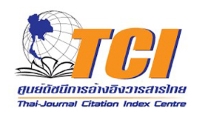JOURNAL DETAIL
Proteomic Analysis of Bradyrhizobium japonicum USDA110 in Acidic Condition
Paper Type |
Contributed Paper |
Title |
Proteomic Analysis of Bradyrhizobium japonicum USDA110 in Acidic Condition |
Author |
Napat Puranamaneewiwat [a,b] Shigeyuki Tajima [c] and Hataichanoke Niamsup* [b] |
Email |
scchi029@chiangmai.ac.th |
|
Abstract: Bradyrhizobium japonicum is an agriculturally important bacterium due to its capacity of nitrogen-fixing symbiosis with leguminous plants, especially soybean (Glycine max). In this report, we studied acid-tolerance metabolism of B. japonicum USDA110 using proteome analysis. Two-dimensional electrophoresis gel image analysis revealed 568 and 628 protein spots of cells grown at pH 4.7 and pH 6.8, respectively. Only 84 protein spots with at least 3-fold differential expression were further identified by MALDI-TOF MS. The annotated proteins were assigned to four different classes: (i) proteins produced only at pH 4.7 condition (15 proteins such as D-alanine aminotransferase, 2-haloalkanoic acid dehalogenase and periplasmic mannitol-binding protein); (ii) proteins produced under both conditions but strongly induced
at pH 4.7 (27 protein spots such as triosephosphate isomerase, UTP-glucose-1 phosphate uridylyltransferase and glyceraldehyde 3-phosphate dehydrogenase); (iii) proteins down-regulated during growth at pH 4.7 (25 proteins such as GroEL, acyl-CoA dehydrogenase and ATP synthase beta chain), and (iv) proteins specific to growth at pH 6.8 (17 proteins such as ATPdependent protease ATP-binding subunit, N-utilization substance protein A and 2- isopropylmalate synthase). The data of the differential protein expression can be a basis for mechanism elucidation of the acid response in B. japonicum USDA110. |
|
Start & End Page |
335 - 345 |
Received Date |
2006-01-01 |
Revised Date |
|
Accepted Date |
2006-05-03 |
Full Text |
Download |
Keyword |
acidic condition, Bradyrhizobium japonicum, proteomic, rhizobium, two-dimensional gel electrophoresis |
Volume |
Vol.33 No.3 (SEPTEMBER 2006) |
DOI |
|
Citation |
[a N.P., [c] B.S.T. and [b] H.N., Proteomic Analysis of Bradyrhizobium japonicum USDA110 in Acidic Condition, Chiang Mai Journal of Science, 2006; 33(3): 335-345. |
| View:896 Download:237 | |
RELATED ARTICLE
Proteomic Analysis of Banana Seedling (Musa ABB cv. 'Kluai Namwa Mali-ong) Infected with Fusarium oxysporum f. sp. cubense (FOC)
Article ID: e2025060
Author:Panatda Jannoey, Duangdao Channei, Pakpoom Subsoonthorn, Kawee Sujipuri, Kumrop Rattanasut and Sittiruk Roytakul
Vol.52 No.5 (September 2025) View: 857 Download:399
Article ID: e2025060
Author:Panatda Jannoey, Duangdao Channei, Pakpoom Subsoonthorn, Kawee Sujipuri, Kumrop Rattanasut and Sittiruk Roytakul
Vol.52 No.5 (September 2025) View: 857 Download:399
Different Levels of Nitrogen Fertilizer in Nursery Stage Positively Affect the Activity of Defense-related Enzymes and Resistance of Tobacco Plant to Phytophthora nicotianae
page: 551 - 554
Author:Ruifang Song, Waqar Ahmed, Yujiao Tan and Zhengxiong Zhao
Vol.49 No.3 (Special Issue II : May 2022) View: 1,675 Download:629
page: 551 - 554
Author:Ruifang Song, Waqar Ahmed, Yujiao Tan and Zhengxiong Zhao
Vol.49 No.3 (Special Issue II : May 2022) View: 1,675 Download:629
Biochemical and Molecular Characterization of Native Rhizobia Nodulating Leucaena leucocephala with Potential Use as Bioinoculants in Yucatan, Mexico
page: 1 - 15
Author:Magnolia Tzec-Gamboa, Francisco Solorio-Sánchez, Immo Fiebrig, Claudia Torres Calzada, Juan J Peña-Cabriales, Elizabeth Ortiz-Vázquez
Vol.47 No.1 (January 2020) View: 1,228 Download:616
page: 1 - 15
Author:Magnolia Tzec-Gamboa, Francisco Solorio-Sánchez, Immo Fiebrig, Claudia Torres Calzada, Juan J Peña-Cabriales, Elizabeth Ortiz-Vázquez
Vol.47 No.1 (January 2020) View: 1,228 Download:616
Comparative analysis of protein profiles of toxic and non-toxic Jatropha curcas latex
page: 1379 - 1391
Author:Lucsame Gurnecka, Eleni Gentekakia, Janthima Jaresitthikunchaib, Teerawit Waratrujiwonga, Sittiruk R
Vol.44 No.4 (October 2017) View: 861 Download:503
page: 1379 - 1391
Author:Lucsame Gurnecka, Eleni Gentekakia, Janthima Jaresitthikunchaib, Teerawit Waratrujiwonga, Sittiruk R
Vol.44 No.4 (October 2017) View: 861 Download:503
Proteomics Profiling and Inflammatory Factor Gene Expression in LPS-Stimulated RAW 264.7 Cells Treated with Crocodylus siamensis Hemoglobin
page: 800 - 815
Author:Nisachon Jangpromma, Natthiya Poolperm, Khanittra Pornsri, Preeyanan Anwised, Thai Kabbua,
Vol.44 No.3 (July 2017) View: 893 Download:413
page: 800 - 815
Author:Nisachon Jangpromma, Natthiya Poolperm, Khanittra Pornsri, Preeyanan Anwised, Thai Kabbua,
Vol.44 No.3 (July 2017) View: 893 Download:413
Diversity of Bacteria Nodulating Medicago arborea in the Northeast Area of Morocco
page: 441 - 452
Author:Kamal Guerrouj* [a], Mustapha Bouterfas[b], Hanaa Abdelmoumen [c] and Mustapha Missbah El Idrissi [c]
Vol.43 No.3 (APRIL 2016) View: 1,333 Download:261
page: 441 - 452
Author:Kamal Guerrouj* [a], Mustapha Bouterfas[b], Hanaa Abdelmoumen [c] and Mustapha Missbah El Idrissi [c]
Vol.43 No.3 (APRIL 2016) View: 1,333 Download:261
Antibacterial Agents from Trichoderma harzianum strain T9 Against Pathogenic Bacteria
page: 304 - 316
Author:Weeraya Phupiewkham, Pisan Sirithorn, Weerasak Saksirirat, Sompong Thammasirirak
Vol.42 No.2 (APRIL 2015) View: 1,414 Download:296
page: 304 - 316
Author:Weeraya Phupiewkham, Pisan Sirithorn, Weerasak Saksirirat, Sompong Thammasirirak
Vol.42 No.2 (APRIL 2015) View: 1,414 Download:296
Proteomic Study of Recombinant Escherichia coli
Expressing Beauveria bassiana Chitinase Gene
page: 324 - 330
Author:Khemika Lomthaisong, Kanchanit Boonmaleerat and Aphinya Wongpia
Vol.35 No.2 (MAY 2008) View: 859 Download:214
page: 324 - 330
Author:Khemika Lomthaisong, Kanchanit Boonmaleerat and Aphinya Wongpia
Vol.35 No.2 (MAY 2008) View: 859 Download:214
Immunoproteomic Assay of Streptococcus suis
Serotype 2 Isolated from Patients
page: 134 - 150
Author:Kanruethai Wongsawan, Aphinya Wongpia, Khemika Lomthaisong, Anuson Boonthum, Volaluck Supjatura, and
Vol.37 No.1 (JANUARY 2010) View: 836 Download:281
page: 134 - 150
Author:Kanruethai Wongsawan, Aphinya Wongpia, Khemika Lomthaisong, Anuson Boonthum, Volaluck Supjatura, and
Vol.37 No.1 (JANUARY 2010) View: 836 Download:281
Diversity of Arbuscular Mycorrhizal Fungi in Mimosa invisa and Effect of the Soil pH on the Symbiosis
page: 517 - 527
Author:Saengdao Kittiworawat, Somchit Youpensuk, and Benjavan Rerkasem
Vol.37 No.3 (SEPTEMBER 2010) View: 864 Download:254
page: 517 - 527
Author:Saengdao Kittiworawat, Somchit Youpensuk, and Benjavan Rerkasem
Vol.37 No.3 (SEPTEMBER 2010) View: 864 Download:254
Copyrights © Since 2021 All Rights Reserved by Chiang Mai Journal of Science










